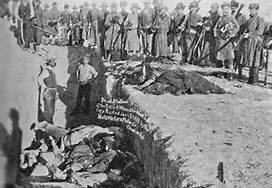The Wounded Knee Massacre
The massacre of Indian men, women, and children in December 1890 ended any significant resistance to U.S. authority and relegated Native American tribes to permanent government dependency.
By the 1890s, most Sioux Indians on the Great Plains had been rounded up and placed on reservations. Desperate to free themselves from U.S. control, the Sioux embraced a new ritual called the Ghost Dance. The Sioux believed that practicing the Ghost Dance would resurrect their ancestors, replenish the buffalo, and wipe the white man off the earth.

Aftermath of the Wounded Knee Massacre
U.S. officials became concerned as the Ghost Dance ritual spread among the reservations. In response, they attempted to arrest Chief Sitting Bull at the Standing Rock Reservation. Sitting Bull was accused of trying to incite an uprising by encouraging the Sioux to practice the Ghost Dance. When Indians resisted the authorities at Standing Rock, a gunfight erupted and Sitting Bull was killed.
The Sioux were so confident that the Ghost Dance would deliver them from U.S. rule that they did not try to avenge Sitting Bull’s death. Instead, many of them fled Standing Rock, with about 100 Hunkpapa Sioux going to the Minneconjou Sioux camp of Chief Big Foot, Sitting Bull’s half-brother. Big Foot was one of the last Indian chiefs that had not yet submitted to U.S. authority.
The U.S. War Department issued a warrant for Big Foot’s arrest as one of the “fomenters of disturbances.” When Big Foot was informed that Sitting Bull had been killed, he led his band toward the camp of Chief Red Cloud on the Pine Ridge Reservation. It was hoped that Red Cloud could negotiate a peace between the Indians and U.S. authorities. Big Foot’s band included 120 men and 230 women and children; most of them had lost relatives in prior conflicts with U.S. forces.
On the way to Pine Ridge, Big Foot was stopped by a portion of the 7th U.S. Cavalry, the same regiment that had been decimated at the Battle of Little Bighorn in 1876. Led by Major Samuel Whitside, the U.S. troopers placed Big Foot in an ambulance because he was suffering from pneumonia and escorted the Indian band to Wounded Knee Creek in South Dakota. Because they arrived at the encampment late in the day, Whitside decided to wait until the next day to disarm the Indians.
That night, the rest of the 7th Cavalry arrived with their commander, Colonel James W. Forsyth. Forsyth informed his men that the Indians were to be taken to the Union Pacific Railroad the next day and transported to a military prison in Omaha, Nebraska. After stationing sentinels and four Hotchkiss guns to prevent escape, Forsyth and his men drank to celebrate Big Foot’s capture. Meanwhile, fearful rumors spread through the Indian camp that the U.S. troopers would avenge their defeat at Little Bighorn.
The next morning, the Indians were issued breakfast rations and informed that they would be taken to Pine Ridge. The Indians were then notified that they would be disarmed. They stacked their arms for collection, but the troopers also searched tepees and seized axes, knives, and other items that could be used as weapons. The troopers then searched the Indians themselves. Two rifles were found, and when an Indian objected to surrendering his weapon because he had paid a high price for it, the gun discharged and the troopers opened fire.
The Indians tried fleeing, but the Hotchkiss guns shredded the camp. When the firing stopped, it was reported that 84 men, 44 women, and 18 children were killed, including Big Foot. U.S. forces suffered 25 dead and 39 wounded, but since few Indians had access to weapons, most of the U.S. casualties were due to friendly fire. Because of an approaching blizzard, the Indian corpses were left where they lay until a civilian detail came to bury them in a mass grave. Of the 350 Indians who had been detained at Wounded Knee, only four men and 47 women reached Pine Ridge.
A band of Sioux attacked the 7th Cavalry the day after the incident, but the 7th was rescued by the black troopers of the 9th Cavalry, and the Indians were too hungry and demoralized to resist any further. Although General Nelson A. Miles described the incident as a “massacre” to the commissioner of Indian Affairs, the U.S. government awarded 20 medals of honor for the action. The Indians were finally dispersed among various reservations where they lived in poverty for generations.
Black Elk, an Oglala Sioux medicine man who was injured at Wounded Knee, recalled the tragic incident: “I did not know then how much was ended. When I look back now from this high hill of my old age, I can still see the butchered women and children lying heaped and scattered all along the crooked gulch as plain as when I saw them with eyes still young. And I can see that something else died there in the bloody mud, and was buried in the blizzard. A people’s dream died there. It was a beautiful dream… the nation’s hoop is broken and scattered. There is no center any longer, and the sacred tree is dead.”
Primary Sources:
Bury My Heart at Wounded Knee by Dee Brown
A Patriot’s History of the United States by Larry Schweikart and Michael Allen
A People’s History of the United States by Howard Zinn





